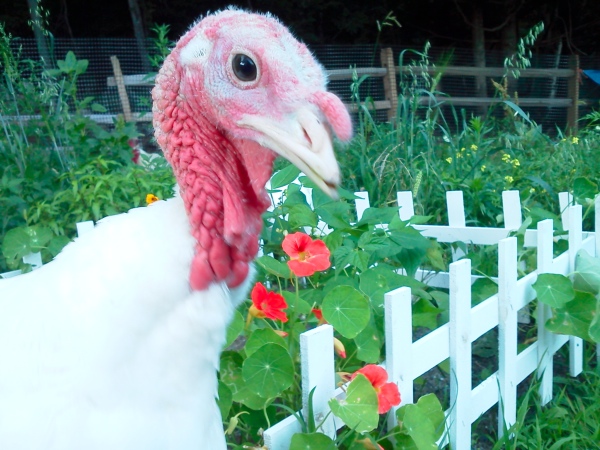A friend of mine once shared the following observation: Flower gardeners don’t always end up growing vegetables, but vegetable gardeners ALWAYS end up growing flowers too, just for the fun of it.
Luckily, it’s possible to indulge a bent for pretty blooms in a way that enhances your edible gardening. Some flowers are themselves edible. Others are formidable partners in companion planting, preventing insect problems without the use of insecticides or other chemicals. And some flowers are both edible and helpful.

Don’t be distracted by the photo-bombing young turkey — those are nasturtiums along with bean plants in one of the mini-gardens tucked into the “Wayne’s World” foraging yard.
Here are just a few of the flowers you can grow with the intention of including them in what I like to call “flower power” salads:
- Bachelor’s buttons—these easy-to-grow and self-seeding flowers taste mild and sweet
- Borage—the tiny blue flowers of this gangly medicinal herb taste sweet and vaguely cucumber-y
- Calendula—the petals of these daisy-like flowers (which are also used in herbal teas and remedies) tend to be tangy
- Dandelion (yes, some people grow them deliberately!)—in addition to being fodder for jellies and wines, the yellow petals of these flowers add a splash of sunshine to salads; very young leaves (from before the plant flowers) can be added sparingly as greens
- Lavender—also used in baking, lavender flowers are the most flowery tasting of the edible flowers
- Nasturtiums—the beautiful flowers of these hardy plants often have a tangy, almost mustard-y taste. The peppery leaves are also edible, although most people will want to include them sparingly with other greens.
- Violets—From wild johnny-jump-ups to cultivated pansies, the flowers of the viola family tend to have a delicate flavor that is both sweet and lightly flowery
BONUS: Many of the flowers of your vegetable and herb plants are themselves edible! Squash blossoms are delicious, lightly battered and quick-fried. Flowers from herbs such as basil, sage, and the like add a dash of that herb’s flavor, but more delicately and sweetly than the leaves. If your mustard, arugula, or radish plants bolt, those flowers can add a jolt of spice.
But the benefits of flowers in the vegetable garden are more than culinary. Flashy flowers may attract pollinators, who then stick around to attend to other plants. Other flowers, like those of calendula, dandelion, and dill, attract beneficial insects like ladybugs. Others, like nasturtium and marigolds, may attract harmful insects to themselves, saving your other plants from them.
Marigolds are my go-to plant for every vegetable garden. Early in the season, insects munch on them rather than on tender vegetable seedlings. Even before they bloom, and especially afterwards, strongly scented marigolds planted around the garden can prevent some harmful insects from locating the vulnerable plants within. Planted right next to, say, a tomato plant, marigolds seems to confuse the scent-scape, making it difficult for insects who devour tomato plants to find their target. The benefits of marigolds don’t end there. The roots of marigolds protect themselves and surrounding plants from underground parasites known as nematodes. And, there are even edible marigolds (the “gem” varieties), although I personally find the strong citrus-y flavor to be distasteful (and those are less helpful with nematodes.)
I’m a living example of my friend’s adage. I did started out including only marigolds (because I had read about them in the gardening book that started it all for me) in a very utilitarian fashion. But then I noticed how much I liked seeing their blooms. And so, each year, more or different flowers found their way among the vegetables.
In short, flowers in the vegetable garden can both spice up your vegan diet and be part of a veganic process of gardening by setting up vibrant and dynamic plant communities. It’s not too late to tuck a few flowers into your garden this year. Give it a try!
This is part five of our series on veganic gardening, which will continue throughout the year. Click here to see the whole series so far. Subscribe to this blog to make sure you don’t miss future posts.





My favorite flowers in my vegetable garden are the sunflowers! They attract bees (and make squirrels happy).
A first, I was afraid my cats could prey on squirrels, but they actually are frightened a bit by them, so they keep their distance or come back inside when the squirrels arrive. Very funy to watch.